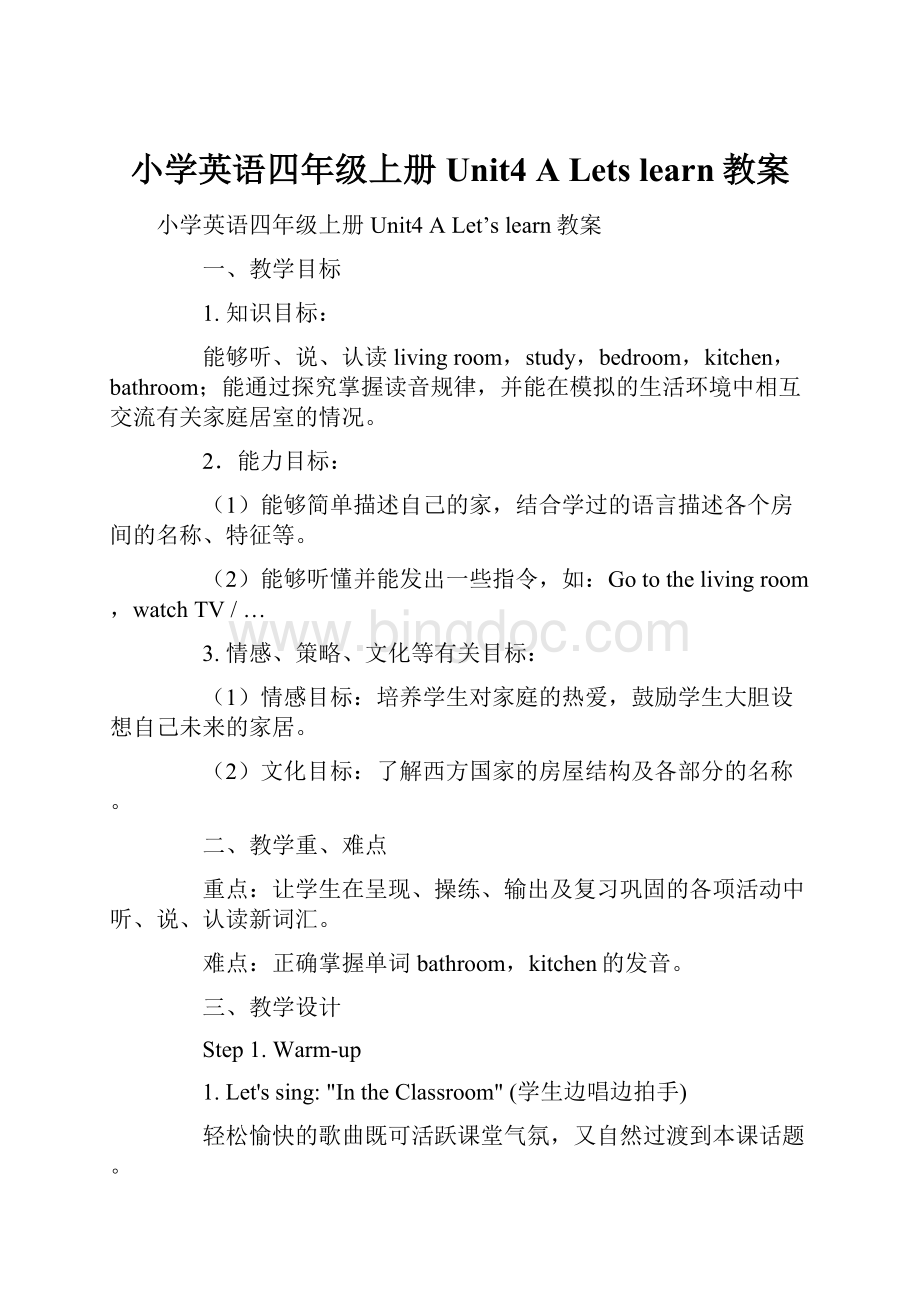小学英语四年级上册Unit4 A Lets learn教案.docx
《小学英语四年级上册Unit4 A Lets learn教案.docx》由会员分享,可在线阅读,更多相关《小学英语四年级上册Unit4 A Lets learn教案.docx(8页珍藏版)》请在冰点文库上搜索。

小学英语四年级上册Unit4ALetslearn教案
小学英语四年级上册Unit4ALet’slearn教案
一、教学目标
1.知识目标:
能够听、说、认读livingroom,study,bedroom,kitchen,bathroom;能通过探究掌握读音规律,并能在模拟的生活环境中相互交流有关家庭居室的情况。
2.能力目标:
(1)能够简单描述自己的家,结合学过的语言描述各个房间的名称、特征等。
(2)能够听懂并能发出一些指令,如:
Gotothelivingroom,watchTV/…
3.情感、策略、文化等有关目标:
(1)情感目标:
培养学生对家庭的热爱,鼓励学生大胆设想自己未来的家居。
(2)文化目标:
了解西方国家的房屋结构及各部分的名称。
二、教学重、难点
重点:
让学生在呈现、操练、输出及复习巩固的各项活动中听、说、认读新词汇。
难点:
正确掌握单词bathroom,kitchen的发音。
三、教学设计
Step1.Warm-up
1.Let'ssing:
"IntheClassroom"(学生边唱边拍手)
轻松愉快的歌曲既可活跃课堂气氛,又自然过渡到本课话题。
2.Freetalk:
T:
Hello!
Boysandgirls!
(指着教室问学生)What'sthis?
Ss:
Thisisourclassroom.
T:
Howmanyboards/windows/...canyousee?
S:
Icanseetwogreenboards/sixwindows/...
T:
Whatcanyoudointheclassroom?
S1:
Icanwashthewindowsintheclassroom.
S2:
Icansweepthefloorintheclassroom.
...
T:
Yeah.Ourclassroomissobig,socleanandsobeautiful.
复习所学句型,拓宽学生思路;师生进行自由对话,为新授知识做好铺垫。
Step2.Presentation
1.livingroom
T:
(课件呈现哆啦A梦)Whoishe?
Ss:
Heis哆啦A梦.
T:
Isheinourclassroomnow?
Ss:
No.
T:
Wherecanyousee哆啦A梦?
S:
Icansee哆啦A梦inthebooks/pictures/TV.
利用学生喜欢的卡通人物,激发学生的好奇心,引起学生想看、想说的欲望。
T:
(学生一说出TV就问)ButwhereistheTV?
S1:
It’sintheclassroom.
T:
Maybe.
S2:
It'sinthe...
通过想一想、说一说,激发学生积极思维,培养学生的口头表达能力。
T:
(课件呈现客厅)Look.It'sinalivingroom.Readafterme./v/,/v/livingroom.
Ss:
(Readittogether,fourbyfour,onebyone)
渗透音素教学。
T:
Whatcanyoudoinalivingroom?
S1:
IcanwatchTVinalivingroom.
S2:
Icansweepthefloorinalivingroom.
...
T:
OK.IwanttowatchTVnow.Let'sgotothelivingroomandwatchTV.
Ss:
(Sayandact)(学生边说边做)
通过TPR活动,激发兴趣.帮助记忆。
2.study
T:
IliketowatchTV.Ialsolikecomputergames.Doyoulikecomputergames?
Ss:
Yes.(学生大声回答)
T:
Doyouplaycomputergamesinalivingroom?
S1:
Yes,Ido.
Ss:
Notforme.Iplaycomputergamesinmy"书房".
T:
Yes,weoftenplaycomputergamesina"study".Butwecan'tplaytoolongtime.
寓思想教育于教学之中。
T:
Readafterme.(用升、降调领读)
Ss:
(onebyone)
T:
(课件呈现书房)Whatcanyouseeinthestudy?
S:
Icanseeadesk/achair/manybooks/...inthestudy.
联系学生生活实际进行操练,使他们既感兴趣,又能把学到的知识运用到实际生活中去。
T:
Doyoulikethestudy?
Why?
S1:
Yes.Icanplaycomputergamesinthestudy.
S2:
Ilikethestudy.Icanreadstory-booksinthestudy.
...
T:
Yes.Wealllikereadingbooksinthestudy.Let'sgotothestudy.OK?
(教师用夸张的语气讲述,好象真地要带学生去书房)
Ss:
OK.
T:
Gowithme.Gotothestudy.Readabook.
Ss:
(学生起立跟着教师边说边做)
TPR活动。
3.bedroom
T:
(课件呈现一名学生躺在床上看书)Canwereadbooksinbed?
Ss:
No,wecan't.
培养学生良好的读书习惯.并为下一步活动做铺垫。
T:
Wecansleepinbed.Whereisthebed?
S:
It'sinthe"bedroom".(强调发音,防止学生读成bed-room)
T:
Listentome,please.bedroom,/dr/,/u:
/,/dru:
/,bedroom.(纠音)
Ss:
(Saywithme.Readittogether,fourbyfourandonebyone.)
滲透音素教学。
T:
OK.Look!
Whatcanyouseeinthebedroom?
(课件呈现)
S1:
(Icanseeabed/apicture/...inthebedroom.
培养学生的观察力和语言表达能力。
T:
Let'sgotothebedroomandhavearest.(Singthesong"MyBedroom"Inmybedroom,inmybedroom,nearthetableandthechair.Youcanseemylittleteddybearsleepinginmylittlebed)
S:
(学生随着音乐跟唱)
T:
(唱完后)Who'sinthebedroom?
Ss:
Teddybear.
通过音乐教学,使学生在轻松愉快的教学中说、练单词,寓教于乐.在乐中学、学中乐,同时提高学生的听力水平。
4.kitchen
T:
(紧接着点击课件,发出碗被打碎和猫叫的声音)Whathappened?
Who'scoming?
Ss:
Cat.
形象生动的声音引起学生的注意力,听音猜物,效果明显。
通过猜的游戏给学生营造了一个想象的空间,不仅巩固了所学的词汇,还锻炼了学生的语言表达能力。
T:
Whereisthecat?
Isitinthe...?
S1:
Isitinthelivingroom?
T:
No,itisn't.
S2:
Isitinthebedroom/study/...?
T:
(课件呈现小猫在厨房打碎碗的情景)Look!
Thecatisinthe"kitchen"(升、降调)/i//i/kitchen.
Ss:
(Saywithme.Readittogether,fourbyfourandonebyone.)
创设语境,学习语言。
T:
Thecatishungry.I'mhungry,too.Icanhavesomenoodlesinthekitchen.Whataboutyou?
S1:
Icanhavesomechickeninthekitchen.
S2:
Icanhavesomecakeinthekitchen.
...(要求学生边说边做动作)
TPR活动。
T:
Wecanalsohaveasnack.Look!
Thisisasnack.(出示实物.帮助学生理解snack)
Ss:
Wow!
Yummy!
(学生表现出很想吃的样子)
T:
Let'sgotothekitchen.Haveasnack.
(学生跟着教师边说边做动作)
通过实物呈现,使情境更趋真实,帮助学生认识新词。
5.bathroom
T:
(教师吃完后看着自己的手说)Wow!
Myhandissodirty.Icanwashmyhandsinthe"bathroom"./a:
//ba:
/,bathroom.
Ss:
(Saywithme.Readittogether,fourbyfourandonebyone.)
融入音素教学,解决难点。
T:
(课件呈现四个不同的浴室)Ihavefourbathrooms.Whichbathroomdoyoulikebest?
Why?
S1:
Ilikebathroom3.It'sbigandclean.
S2:
Ilikebathroom1.It'sblue.Ilikeblue.
...
让学生通过判断拓展思维,增强学习兴趣。
T:
Whatcanyoudointhebathroom?
Discussinfour.
Ss:
(学生讨论)
T:
OK.Whowantstohaveatry?
S1:
Icanwashmyhands/face/...inthebathroom.
T:
Wecanalsotakeashowerinthebathroom.Let'sdo.
T:
Wecandodifferentthingsindifferentrooms.Let'sdo.
(Sslistentothetapeanddoactions.)
通过小组讨论,相互交流,使学生思维活跃,培养学生的发散性思维。
3.Step3.Extension/Consolidation
活动一:
Guessinggame:
Whereishe/she?
1.T(课件):
It'stimetoplayagame.Let'splayagame.OK?
Ss:
OK.
T:
(Askonestudenttocometotheboardanddoactions.wherehe/sheis)
T:
(做刷牙状)WhereisMissZhu?
Ss:
MissZhuisinthebathroom.
T:
Whowantstohaveatry?
S:
...
生动的表演,激烈的竞猜,使课堂充满乐趣。
该游戏不仅能巩固知识,培养学生想象力,还可以提高学生对肢体语言的理解力和表演能力。
活动二:
Findfriends(Readandfindout)
T:
Ihavefivefriendswhoarethey?
T:
(课件呈现)
Friendone:
I'mbig.IhaveaTV.Ihavetwosofas.WhoamI?
Friendtwo:
I'mbig,too.I'mnice.Ihaveapinkbed.Ihavemanypictures.WhoamI?
Friendthree:
I'msmall.Ihavemanybooks.Ihaveawhitecomputer.Ihavemanyfriends.WhoamI?
Friedfour:
I'mverysmall.Icanmakeyouclean.WhoamI?
Friedfive:
I'mclean.Ihavemanyapples.Ihavehamburgers.Icanmakeyoustrong.WhoamI?
Ss:
(Readtogetherandguesswhatroomstheyare.)
在前面听说的基础上,用游戏教学来实现对单词和句子的认读,还可增加生活常识,培养学生的认读能力,进一步巩固所学语言知识。
活动三:
Rentahouse
(课件呈现;Katewantstorentahousewithabedroom,abathroom,andakitchen.Nowyouhaveahouseforrent.YoucanintroduceyourhousetoKate.)
Forexample:
Ihaveahouseforrent.Look!
Thisismyhouse.Abedroom,abathroomandakitchen.Look!
Thisisthebathroom.It'ssobigandnice.Thisisthebedroom.Youcanseealampandabedinit.Thisisthekitchen.It'ssobigandclean.Doyoulikemyhouse?
模拟真实情境,使学生把所学的语言运用到实际生活中,给学生充分的表演空间,拓展学生思维,培养他们实际运用语言的能力。
T:
Now,discussinyourgroup.YouCanusethesessentences:
(课件呈现可用句型:
Ihave...
Look!
Thisisthe...It's...
Youcansee...
Doyoulikemyhouse?
(Ssdiscussinfour,thenactoutinclass.)